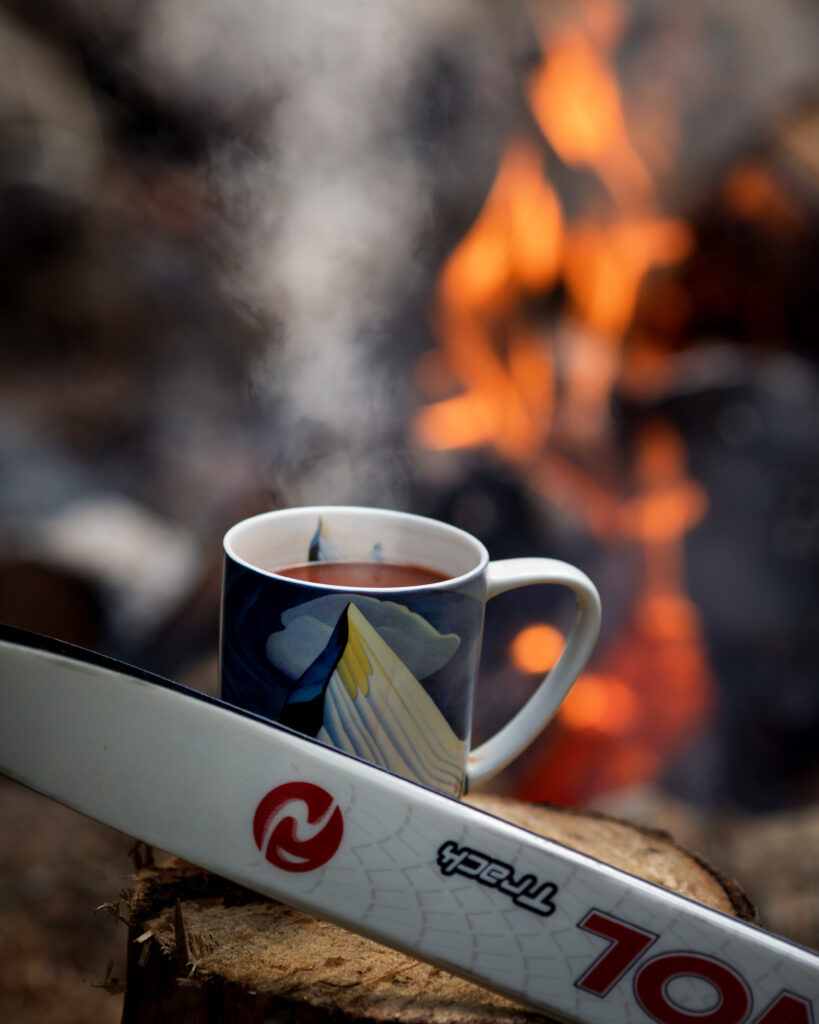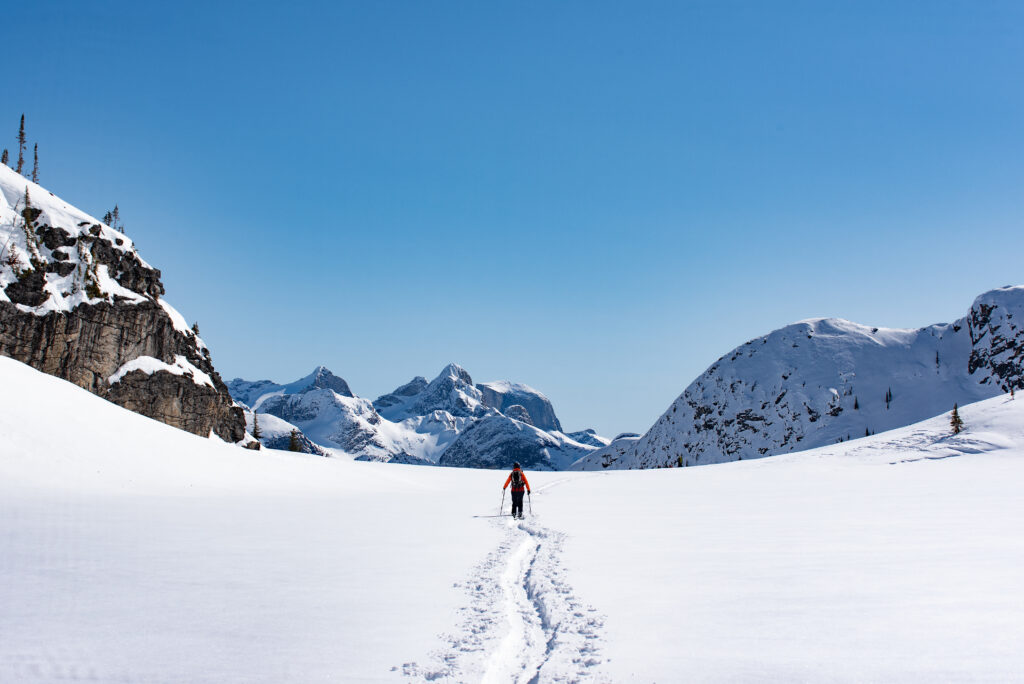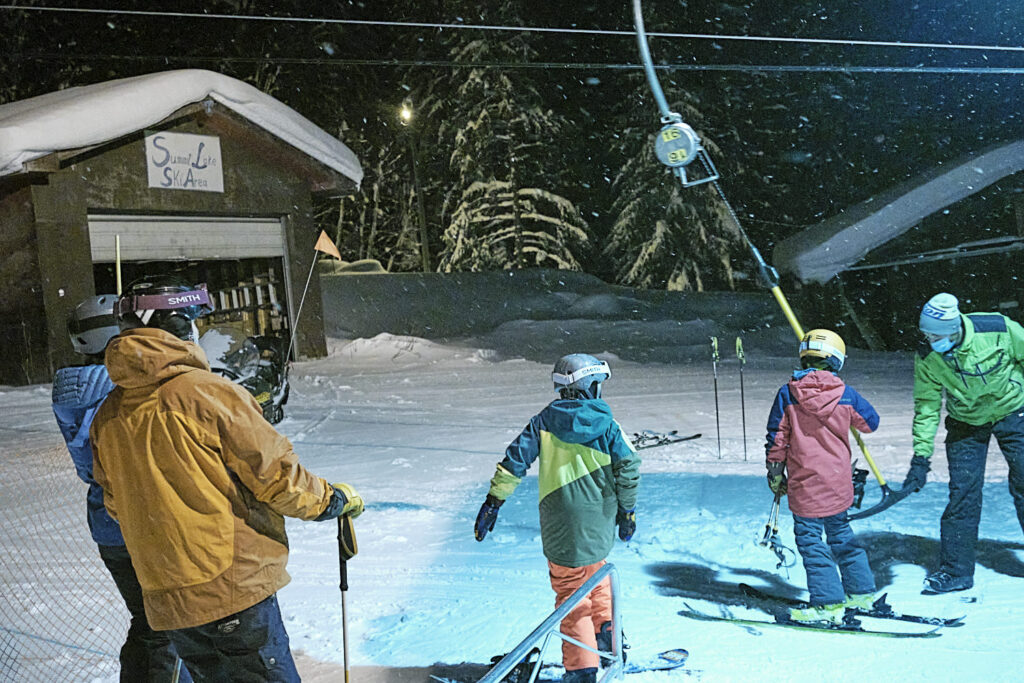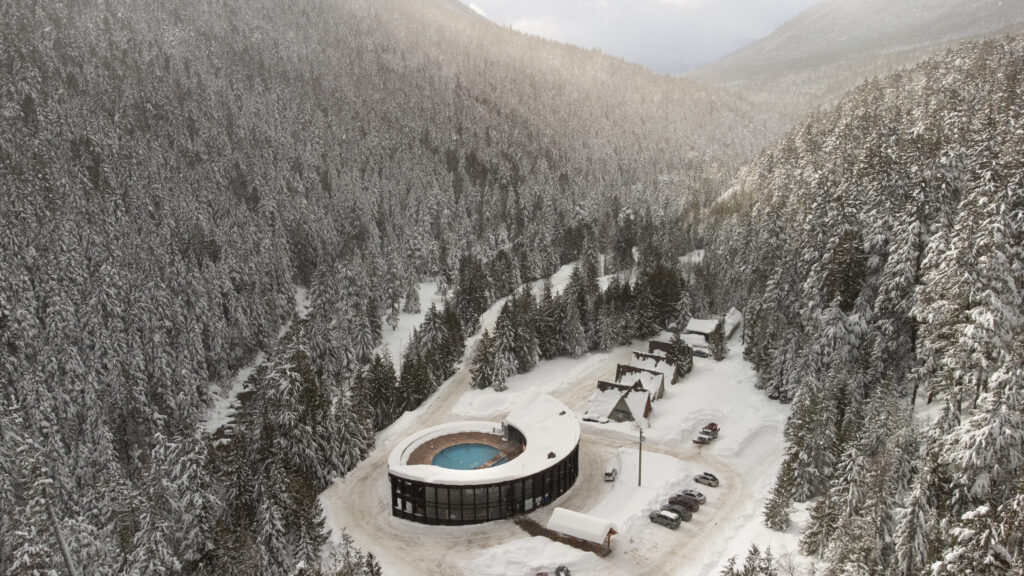By Jayme Moye
Besides the swish of my cross-country skis on the snow, the only sound is the occasional cheep of a chickadee or twitter of a nuthatch—hardy little birds that live year-round in the surrounding cedar-hemlock forest. Evidence of their enduring presence, on even the snowiest day, always makes me smile. I pick up the pace, drawing strength from the solitude. As the trail takes me deeper into the wilderness, I start to see witch’s hair, a long, ice-green lichen, dangling from nearly every tree bough. I know this species as one that can only survive in the cleanest air, which feels a bit surreal considering the trail I’m on is a former railway. Wood-burning locomotives once shuttled silver-lead ore down this path, from Sandon to Kaslo. The Sandon mines have long-since closed, and a warming hut with a wood-burning stove has replaced the rail station, beckoning Nordic skiers to reimagine the pathway into the woods.
Experiences like this are a big part of the reason I moved from the Rocky Mountains of Colorado, in 2017, to the Selkirk Mountains of British Columbia. Winter is my favourite season; I love being outside in the snow. I was looking for a homebase with a strong, deep culture of wintertime recreation, but without the crowds—a place where I could slow down enough to learn the names of the birds, the mammals, the trees. I found all of that, and more, in the Arrow Slocan region of B.C., which encompasses the Selkirks and parts of the Monashee mountain ranges as well as the Arrow and Slocan lakes.
Here’s how to best experience this idyllic region in winter, from the snow sports to the cozy café culture.
The Top Spots for Cross-Country Skiing and Snowshoeing
In addition to the K&S Rail Trail, where I skied with chickadees and nuthatches, the Arrow Slocan region contains 80 kilometers of groomed cross-country skiing trails across five locations. K&S Rail Trail is the shortest—a 3-km track set for classic cross-country skiing. But it offers the biggest dose of history with its proximity to the ghost town of Sandon.
The longest is the Slocan Valley Rail Trail, which follows the scenic Slocan River for 52 glorious kilometres. This trail is typically groomed for both classic cross-country and skate, but it’s all done by local volunteers so may not be consistent between its seven trailheads. At the north end of the valley, just beyond the aptly-named hamlet of Hills, enjoy 11 kilometres of undulating skate and classic ski trails at the Valhalla Hills Nordic area. The Valhalla Hills Nordic Club also grooms 5 km of the N&S Rail Trail, accessed off the end of Rieben Road.

Further north, the Arrow Lakes Cross-Country Ski Club maintains the Wensley Creek Ski Trails: 8 kilometres of groomed trails with a warming hut. The Rabbit Interpretive Trail, also at Wensley Creek, was created specifically for snowshoeing, and features interpretive signs along the 4-km out-and-back path through the woods. Snowshoeing enthusiasts also get their fix on the Hot Springs Trail, an 8.5-kilometre out-and-back along the Kuskanax River Canyon between Nakusp Hot Springs and the town of Nakusp.
The Best Backcountry Skiing
With such a vast mountain wilderness and so little development, not to mention the 500-or-so inches of snow that fall every winter, Arrow Slocan is a backcountry skier’s dream. Four different backcountry lodges have each carved out their own little slice of high-elevation paradise within the region. In the Selkirk Mountains, you’ll find Valhalla Mountain Touring just north of Valhalla National Park. Also in the Valhalla range, but on the south side of the park, is Ice Creek. In the Valkyr subrange of the Selkirks, Valkyr Adventures has a collection of three lodges. To the northwest, in the Monashee Mountains, is the Sol Mountain lodge.

There are no roads leading to these lodges. With the exception of Valhalla Mountain Touring, which uses a snowcat to shuttle guests, each requires a helicopter to access. Backcountry lodge season in the Arrow Slocan region typically runs from December through April, with all-inclusive stays ranging from three to six days. And while every lodge does things a little bit differently, you can expect small groups, expert local guides, comfy private rooms, chef-prepared meals, and wood-fired saunas. Plus tens of thousands of acres of untouched powder outside your front door, with not another person outside of your group in sight.
The world’s largest heli-skiing operator, CMH, also runs tours in the Arrow Slocan region. CMH Kootenay bases out the Lodge at Arrow Lakes in Nakusp, offering four- and five-day trips for up to 11 expert skiers into some of the most sought-after freeriding terrain in the Valhallas.
Resort Skiing in Arrow Slocan
The Arrow Slocan region is bookended by two legendary B.C. ski resorts, Revelstoke Mountain Resort, to the north, and Whitewater Ski Resort, to the south. But since 1961, kids growing up in the small towns dotting this region have had their first experience sliding on snow at Summit Lake Ski and Snowboard Area. Located 18 kilometres southeast of Nakusp, the ski area, or “hill” as we affectionately call it, features eight runs accessed via a T-bar, with a vertical drop of 152 metres. Friday evenings are the best, when spirited night skiing draws kids of all ages.

Where to Stay
In a region with not one, but two, world-class hot springs resorts, lodging is a no brainer. Choose the charming Nakusp Hot Springs Chalets for a quintessential Arrow Slocan experience. Or go a bit further north for high-end luxury at Halcyon Hot Spring Resort, where offerings range from a studio suite to a family-sized cottage in the forest. Don’t miss dinner with a view at Alcédo, the resort’s fine-dining restaurant serving up west coast inspired, farm-to-table cuisine.

Beyond the hot springs resorts are a variety of unique accommodations that perfectly capture the eclectic, creative vibe of the mountain and lakeside communities in the Arrow Slocan region. My first suggestion for visitors is always the Adventure Domes in New Denver. Quirky yet stylishly comfortable, the cedar-paneled dome cottages are a must-see in their own right. For something more secluded, I recommend the Kootenay Lakeview Retreats, luxury cabins south of Nakusp, situated either on Arrow Lake or in the adjacent forest. The newest boutique hotel in the Arrow Slocan region is Slocan City Hotel, a historic building that the new owners, including Johnny Pettigrew, a local musician, spent about five years renovating into three small but well-appointed hotel rooms, two one-bedroom suites with kitchens, and a gastro pub called The Lobby Grill.
Where to go for Coffee
Places with long, snowy winters tend to have vibrant café cultures, and Arrow Slocan is no exception. Spend enough time sipping and snacking in our local coffee shops and you’ll come to understand that it’s also the ambiance that makes these community gathering spots so compelling. Frog Peak Café in Crescent Valley is located in a 100-year-old house across the street from the Slocan Rail Trail, with just as much art on the outside as inside. You can rent the handsome upstairs apartment on AirBnb. Camp Café in Silverton doubles as an artisan gift shop, offering locally-made jewelry, pottery, and bed and bath products, alongside tasty muffins and quiche. At Nuru Coffee Bar in New Denver, you’ll most likely meet owner Tamara, who does much of the baking herself. Alongside the coffee and espresso, she also serves Virtue Tea, an ethically sourced, small batch, organic tea produced on the other side of the Selkirk Mountains in Nelson. Mountain Top Café in Nakusp is quite possibly the cutest, located inside a little brown A-frame cabin with a wood-burning stove and live plants on the windowsill. They serve another beloved Selkirk Mountain brand, Oso Negro Coffee, with “Prince of Darkness,” one of my all-time faves, typically on drip throughout the winter.
My Next Arrow Slocan Region Winter Getaway
My next Arrow Slocan adventure will be a 4-day backcountry lodge stay. It’s my family holiday tradition (three generations of us!) to spend Christmas in the backcountry, and this year we’ve chosen Valhalla Mountain Touring’s lodge. Our guide will be none other than owner-operator Jasmin Caton, who is not only an Association of Canadian Mountain Guides (ACMG) certified skiing and climbing guide, she’s also a life-long resident of the Selkirk Mountains, a true local expert. Jasmin tells me that the snow is already piling up at the lodge, and that there are massive old-growth spruce trees within its 19,000 acres of skiable terrain. I absolutely can’t wait.
Know Before You Go
Traveling into the backcountry comes with inherent risks. Locals and visitors alike should follow Avalanche Canada’s forecasts and recommendations. For those looking to expand their knowledge, long-time local guiding company Summit Mountain Guides offers multiple Avalanche Skills Training (AST) courses based out of Arrow Slocan region backcountry lodges every winter.
In winter, roads can be icy or snowy. Late at night snow plowing may be limited. Always have dedicated good condition winter tires and be confident driving in winter conditions. Whenever possible, plan your trip to avoid driving in the middle of a storm cycle.
Travel in winter requires additional consideration:
- Dedicated winter tires are highly recommended. All seasons, even those with the snowflake, don’t provide the same kind of traction ideally needed for ice and snow conditions.
- Winter tires or chains are required on most highway routes in British Columbia from October 1 to April 30.
- Slow down to match the road conditions. The max posted speed may not be appropriate for the current winter road conditions.
- Avoid a rush. Give yourself plenty of extra time to arrive at your destination.
Check DriveBC.ca for major road events such as delays, closures and suggested detours:
DriveBC.ca
Highway Webcams
ShiftintoWinter.ca
Winter Driving – Province of BC
Twitter: @DriveBC
In the mountains weather can change quickly. There is often no cell service and in remote areas it is up to you to be prepared to manage emergencies.
Check out AdventureSmart to learn outdoor activity based tips to keep you safe and make sure you get the most out of your next adventure.
Here are a few basics:
- Be sure to tell someone where you are going and when you will be back.
- Plan your route, have a map, know where you are going.
- Know the terrain and conditions.
- Check the weather.
- Have appropriate essentials with you – be prepared to spent a night outside in case of emergency.
- Always pack items such as: warm clothing, flashlight, food, emergency communication device, water, knife, emergency shelter.
- Obtain the knowledge and skills you need before heading out.
- Know and stay within your limits.
- Be aware of wildlife. Learn how to avoid and handle a potential animal encounter safely.
- Dress appropriately for the outdoor environment – consider your footwear and clothing choices.
- Get the training needed for land, water and winter travel – and the right safety gear to head out on a trip.
- Don’t assume Search and Rescue (SAR) will be able to come for you in an emergency. Weather or hazardous conditions will prevent SAR from responding to a call until it is safe to do so. Be prepared for self rescue and to overnight.
